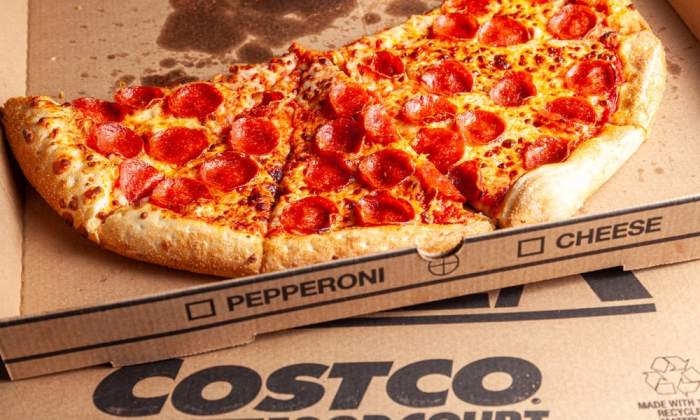Costco Pizza Nutrition Facts A Detailed Analysis
Costco Pizza Nutritional Content Overview

Costco pizza nutrition facts – Costco’s pizzas are known for their generous size and affordability, but understanding their nutritional content is crucial for making informed dietary choices. This overview provides a general guide to the nutritional information typically found in a slice of Costco pizza, highlighting variations across different types and emphasizing the importance of considering serving sizes. Keep in mind that nutritional values can vary slightly depending on the specific ingredients and preparation methods.
Typical Nutritional Information per Slice
The following table provides a general overview of the nutritional content of a typical Costco pizza slice. Note that these are approximate values and can vary depending on the pizza type and size. It’s always best to check the nutritional label on the specific pizza you purchase.
| Nutrient | Cheese Pizza (approx.) | Pepperoni Pizza (approx.) | Veggie Pizza (approx.) |
|---|---|---|---|
| Calories | 500-600 | 550-650 | 450-550 |
| Total Fat (g) | 25-30 | 30-35 | 20-25 |
| Protein (g) | 15-20 | 15-20 | 12-18 |
| Carbohydrates (g) | 50-60 | 50-60 | 45-55 |
| Sodium (mg) | 800-1000 | 900-1100 | 700-900 |
Variations in Nutritional Content Across Pizza Types
Different Costco pizza varieties exhibit noticeable differences in their nutritional profiles.
The nutritional content varies depending on the toppings. For instance:
- Cheese Pizza: Generally lower in calories and fat compared to pepperoni or other meat-topped pizzas, due to the absence of added meats and higher fat toppings.
- Pepperoni Pizza: Higher in calories and fat due to the addition of pepperoni, a processed meat high in saturated fat.
- Veggie Pizza: Can be a relatively lower-calorie and lower-fat option, depending on the specific vegetables used. However, added cheese can increase the fat and calorie content.
Serving Size and its Implications
Costco pizza slices are significantly larger than those found in many other restaurants or pizzerias. The nutritional information provided is typically based on a single slice, which is often considered a serving size. However, a single slice might constitute a substantial portion of a person’s daily caloric intake for many individuals. Consumers should be aware of this large serving size and adjust their consumption accordingly to manage their calorie intake and maintain a balanced diet.
For example, sharing a slice with another person or consuming only half a slice could significantly reduce the overall calorie and fat intake.
Comparison to Other Pizzas

Costco’s pizza is known for its large size and affordability, but how does its nutritional profile stack up against other popular pizza options? This section compares Costco pizza to offerings from national chains, highlighting key nutritional differences and their potential health implications. We will also examine the nutritional aspects of choosing Costco pizza versus making pizza at home.
A direct comparison requires specifying the type of pizza from each establishment. For this comparison, we will assume a similar cheese pizza slice from Costco and a comparable slice from Pizza Hut and Domino’s. Precise nutritional information varies depending on the specific toppings and preparation methods, so these figures represent averages based on readily available nutritional data from the companies’ websites and independent analyses.
Nutritional Comparison of Pizza Slices
The following table presents a simplified comparison of a typical cheese pizza slice from Costco, Pizza Hut, and Domino’s. Remember that nutritional values can vary slightly depending on the specific pizza and preparation method.
| Nutrient | Costco | Pizza Hut | Domino’s |
|---|---|---|---|
| Calories | ~700 | ~280 | ~200 |
| Fat (g) | ~40 | ~12 | ~10 |
| Saturated Fat (g) | ~20 | ~6 | ~5 |
| Sodium (mg) | ~1000 | ~700 | ~600 |
| Carbohydrates (g) | ~60 | ~30 | ~25 |
| Protein (g) | ~20 | ~10 | ~8 |
Note: These values are approximate and based on commonly available nutritional information. Actual values may vary.
Health Implications of Choosing Costco Pizza
The table clearly shows that a Costco pizza slice contains significantly more calories, fat, and sodium than a slice from Pizza Hut or Domino’s. This higher caloric and fat content can contribute to weight gain if consumed regularly. The increased sodium content may also be a concern for individuals with high blood pressure or other sodium-sensitive conditions. However, the larger slice size means a single slice may be more filling, potentially leading to reduced overall calorie intake compared to eating multiple smaller slices from other chains.
Nutritional Advantages and Disadvantages Compared to Homemade Pizza, Costco pizza nutrition facts
Costco pizza offers convenience and affordability, but homemade pizza provides greater control over ingredients and nutritional content. A homemade pizza can be made with whole-wheat crust, lean meats, and plenty of vegetables, significantly reducing the fat, sodium, and calorie content compared to a Costco slice. Conversely, a poorly made homemade pizza, using excessive cheese and processed meats, could easily surpass the nutritional content of a Costco pizza.
FAQ Guide: Costco Pizza Nutrition Facts
Are Costco pizzas healthier than frozen pizzas?
It depends on the specific frozen pizza and the Costco pizza type. Some frozen pizzas may contain higher levels of sodium or unhealthy fats. However, a Costco pizza slice, while larger, may offer a better nutritional profile in some cases.
Does Costco offer any healthier pizza options?
Costco’s veggie pizza generally contains fewer calories and fat compared to pepperoni or cheese options, offering a relatively healthier alternative within their range.
How many slices are typically in a Costco pizza?
A Costco pizza usually has 12 slices, although this can vary slightly.
Can I find nutritional information directly from Costco?
While detailed nutritional information might not always be readily available in-store, you can often find it on the Costco website or by contacting customer service.
